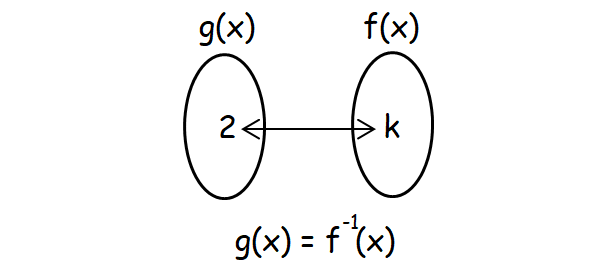DERIVATIVES OF INVERSE FUNCTIONS
Subscribe to our ▶️ YouTube channel 🔴 for the latest videos, updates, and tips.
Conider a function f(x). Let g(x) be the inverse function of f(x). That is,
g(x) = f-1(x)
Take the function f on both sides using the operation function composition.
f ∘ g(x)] = f ∘ f-1(x)
f[g(x)] = f[f-1(x)]
f[g(x)] = f1-1(x)
f[g(x)] = f0(x)
f[g(x)] = x
Find the derivative on both sides with respect to x. (Use chain rule on the left side. That is, first find the derivative of f, then by chain rule, find the derivative of g(x)).
f'[g(x)] ⋅ g'(x) = 1
Divide both sides by f'[g(x)].
Replace g(x) by f-1(x).
Example 1 :
Let g(x) be the inverse of f(x). If f(x) = 2x + 1, find g'(2).
Solution :
Since g(x) is the inverse of f(x),
g(x) = f-1(x)
Formula to find the derivative of g(x).
Substitute x = 2.
Let g(2) = k.
Since g(x) is the inverse of f(x),

Therefore,
f(k) = 2
2k + 1 = 2
Subtract 1 from both sides.
2k = 1
Divide both sides by 2.
k = ½
Since g(2) = k,
g(2) = ½
f(x) = 2x + 1
f'(x) = 2(1) + 0
f'(x) = 2
Substitute x = ½.
f'(½) = 2
Therefore,
g'(2) = ½
Example 2 :
Given : f(x) = x3 + x + 5. If g(x) is the inverse of f(x), find g'(5).
Solution :
Since g(x) is the inverse of f(x),
g(x) = f-1(x)
Formula to find the derivative of g(x).
Substitute x = 5.
Let g(5) = k.
Since g(x) is the inverse of f(x),
f(k) = 5
k3 + k + 5 = 5
Subtract 5 from both sides.
k3 + k = 0
k(k2 + 1) = 0
|
k = 0 |
k2 + 1 = 0 √k2 = √-1 k = √-1 (imaginary) |
Therefore,
k = 0
Since g(5) =k,
g(5) = 0
f(x) = x3 + x + 5
f'(x) = 3x2 + 1
Substitute x = 0.
f'(0) = 3(0)2 + 1
f'(0) = 0 + 1
f'(0) = 1
Therefore,
g'(5) = ¹⁄₁
g'(5) = 1
Subscribe to our ▶️ YouTube channel 🔴 for the latest videos, updates, and tips.
Kindly mail your feedback to v4formath@gmail.com
We always appreciate your feedback.
About Us | Contact Us | Privacy Policy
©All rights reserved. onlinemath4all.com
Recent Articles
-
10 Hard SAT Math Questions (Part - 40)
Dec 18, 25 06:27 PM
10 Hard SAT Math Questions (Part - 40) -
Digital SAT Math Problems and Solutions (Part - 13)
Dec 18, 25 12:26 PM
Digital SAT Math Problems and Solutions (Part - 13) -
90 Degree Clockwise Rotation
Dec 18, 25 09:42 AM
90 Degree Clockwise Rotation - Rule - Examples with step by step explanation

